Taxation Law Case Study: Capital Gains and Home Purchase Analysis
VerifiedAdded on 2023/04/21
|9
|2564
|266
Case Study
AI Summary
This case study examines the taxation implications of financial decisions made by Amber and Jaimie. Amber's case involves the sale of a chocolate shop and an apartment, triggering capital gains tax considerations. The analysis explores potential exemptions, such as the small business CGT concession and the main residence exemption, assessing their applicability based on factors like ownership duration and property usage. Jaimie's case focuses on the tax implications of purchasing a home, comparing a company loan option with direct purchase. The analysis considers interest rates, real estate taxes, and available deductions to determine the most tax-efficient approach. The case study concludes that Jaimie should purchase his own home to take advantage of the tax benefits of 50% deduction, while Amber's tax liabilities depend on her eligibility for CGT exemptions. The analysis provides detailed calculations to support the recommendations, highlighting the importance of understanding taxation law in making informed financial decisions. Desklib provides access to similar case studies and solved assignments for students.
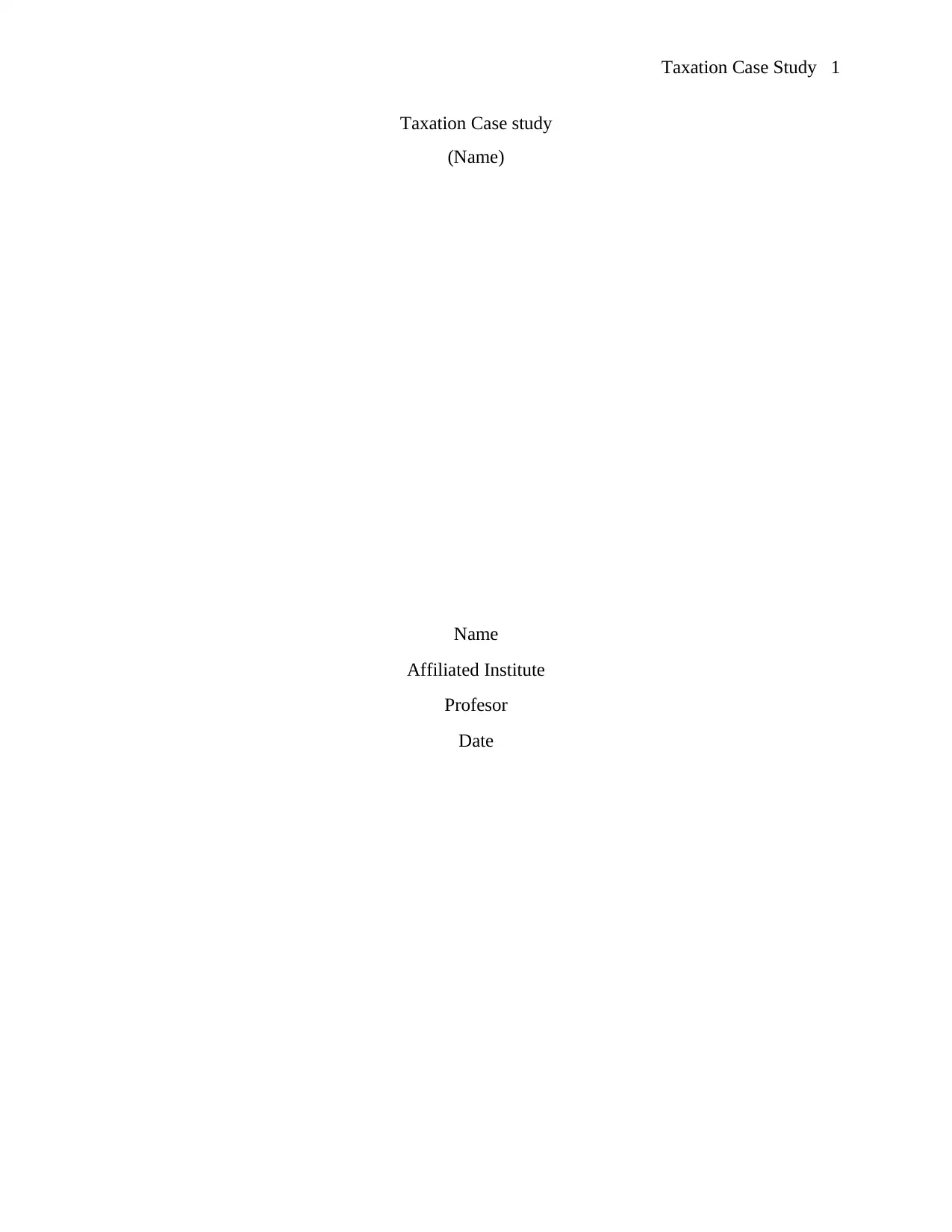
Taxation Case Study 1
Taxation Case study
(Name)
Name
Affiliated Institute
Profesor
Date
Taxation Case study
(Name)
Name
Affiliated Institute
Profesor
Date
Paraphrase This Document
Need a fresh take? Get an instant paraphrase of this document with our AI Paraphraser
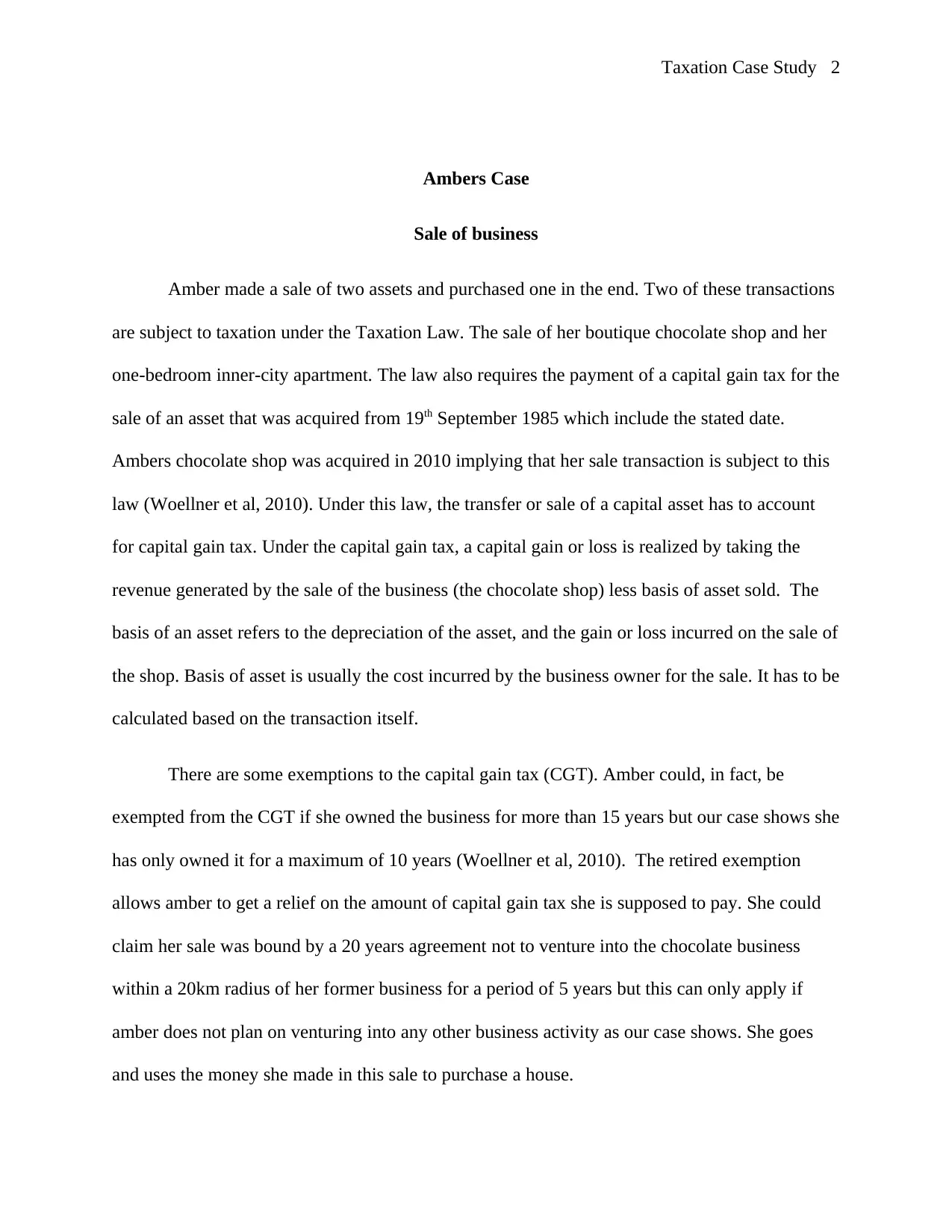
Taxation Case Study 2
Ambers Case
Sale of business
Amber made a sale of two assets and purchased one in the end. Two of these transactions
are subject to taxation under the Taxation Law. The sale of her boutique chocolate shop and her
one-bedroom inner-city apartment. The law also requires the payment of a capital gain tax for the
sale of an asset that was acquired from 19th September 1985 which include the stated date.
Ambers chocolate shop was acquired in 2010 implying that her sale transaction is subject to this
law (Woellner et al, 2010). Under this law, the transfer or sale of a capital asset has to account
for capital gain tax. Under the capital gain tax, a capital gain or loss is realized by taking the
revenue generated by the sale of the business (the chocolate shop) less basis of asset sold. The
basis of an asset refers to the depreciation of the asset, and the gain or loss incurred on the sale of
the shop. Basis of asset is usually the cost incurred by the business owner for the sale. It has to be
calculated based on the transaction itself.
There are some exemptions to the capital gain tax (CGT). Amber could, in fact, be
exempted from the CGT if she owned the business for more than 15 years but our case shows she
has only owned it for a maximum of 10 years (Woellner et al, 2010). The retired exemption
allows amber to get a relief on the amount of capital gain tax she is supposed to pay. She could
claim her sale was bound by a 20 years agreement not to venture into the chocolate business
within a 20km radius of her former business for a period of 5 years but this can only apply if
amber does not plan on venturing into any other business activity as our case shows. She goes
and uses the money she made in this sale to purchase a house.
Ambers Case
Sale of business
Amber made a sale of two assets and purchased one in the end. Two of these transactions
are subject to taxation under the Taxation Law. The sale of her boutique chocolate shop and her
one-bedroom inner-city apartment. The law also requires the payment of a capital gain tax for the
sale of an asset that was acquired from 19th September 1985 which include the stated date.
Ambers chocolate shop was acquired in 2010 implying that her sale transaction is subject to this
law (Woellner et al, 2010). Under this law, the transfer or sale of a capital asset has to account
for capital gain tax. Under the capital gain tax, a capital gain or loss is realized by taking the
revenue generated by the sale of the business (the chocolate shop) less basis of asset sold. The
basis of an asset refers to the depreciation of the asset, and the gain or loss incurred on the sale of
the shop. Basis of asset is usually the cost incurred by the business owner for the sale. It has to be
calculated based on the transaction itself.
There are some exemptions to the capital gain tax (CGT). Amber could, in fact, be
exempted from the CGT if she owned the business for more than 15 years but our case shows she
has only owned it for a maximum of 10 years (Woellner et al, 2010). The retired exemption
allows amber to get a relief on the amount of capital gain tax she is supposed to pay. She could
claim her sale was bound by a 20 years agreement not to venture into the chocolate business
within a 20km radius of her former business for a period of 5 years but this can only apply if
amber does not plan on venturing into any other business activity as our case shows. She goes
and uses the money she made in this sale to purchase a house.
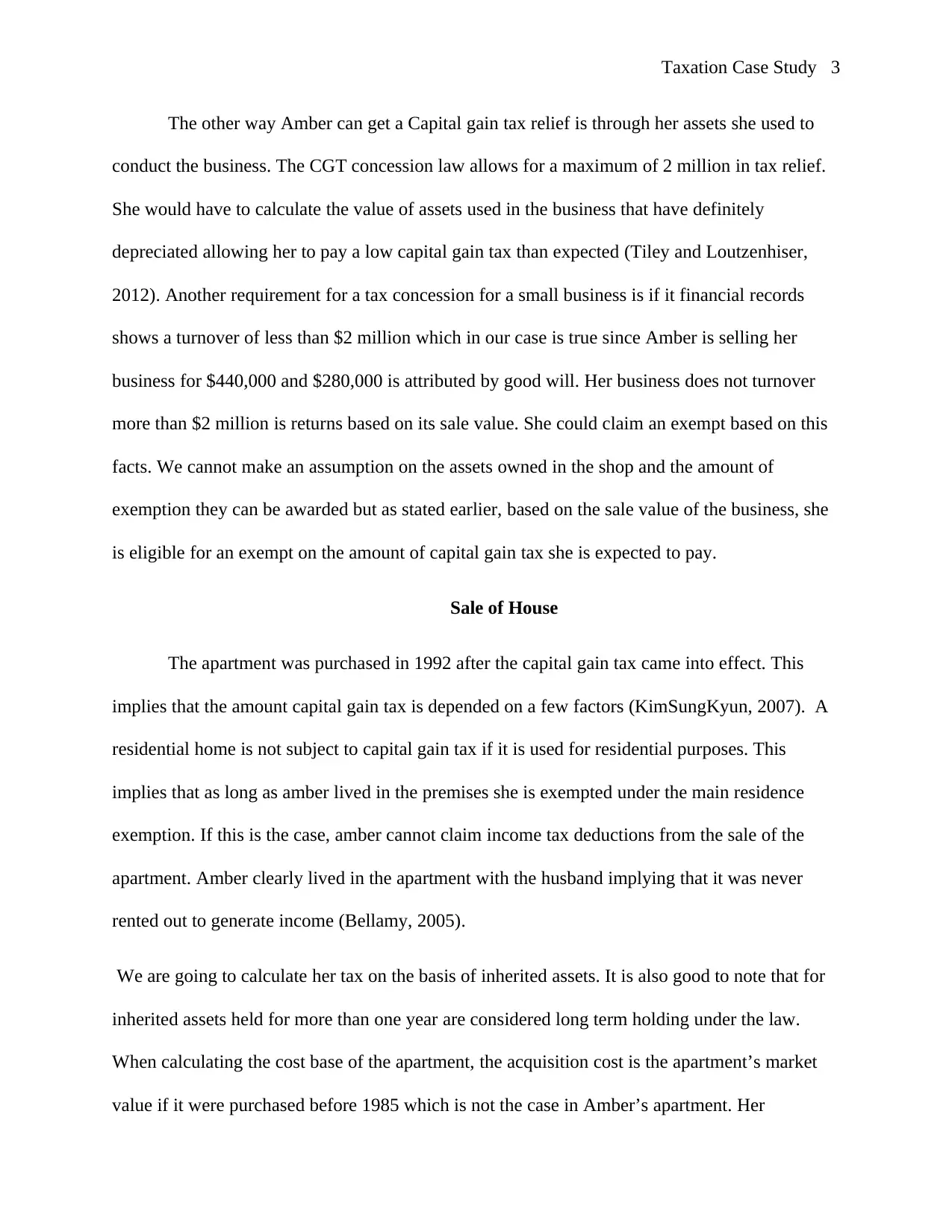
Taxation Case Study 3
The other way Amber can get a Capital gain tax relief is through her assets she used to
conduct the business. The CGT concession law allows for a maximum of 2 million in tax relief.
She would have to calculate the value of assets used in the business that have definitely
depreciated allowing her to pay a low capital gain tax than expected (Tiley and Loutzenhiser,
2012). Another requirement for a tax concession for a small business is if it financial records
shows a turnover of less than $2 million which in our case is true since Amber is selling her
business for $440,000 and $280,000 is attributed by good will. Her business does not turnover
more than $2 million is returns based on its sale value. She could claim an exempt based on this
facts. We cannot make an assumption on the assets owned in the shop and the amount of
exemption they can be awarded but as stated earlier, based on the sale value of the business, she
is eligible for an exempt on the amount of capital gain tax she is expected to pay.
Sale of House
The apartment was purchased in 1992 after the capital gain tax came into effect. This
implies that the amount capital gain tax is depended on a few factors (KimSungKyun, 2007). A
residential home is not subject to capital gain tax if it is used for residential purposes. This
implies that as long as amber lived in the premises she is exempted under the main residence
exemption. If this is the case, amber cannot claim income tax deductions from the sale of the
apartment. Amber clearly lived in the apartment with the husband implying that it was never
rented out to generate income (Bellamy, 2005).
We are going to calculate her tax on the basis of inherited assets. It is also good to note that for
inherited assets held for more than one year are considered long term holding under the law.
When calculating the cost base of the apartment, the acquisition cost is the apartment’s market
value if it were purchased before 1985 which is not the case in Amber’s apartment. Her
The other way Amber can get a Capital gain tax relief is through her assets she used to
conduct the business. The CGT concession law allows for a maximum of 2 million in tax relief.
She would have to calculate the value of assets used in the business that have definitely
depreciated allowing her to pay a low capital gain tax than expected (Tiley and Loutzenhiser,
2012). Another requirement for a tax concession for a small business is if it financial records
shows a turnover of less than $2 million which in our case is true since Amber is selling her
business for $440,000 and $280,000 is attributed by good will. Her business does not turnover
more than $2 million is returns based on its sale value. She could claim an exempt based on this
facts. We cannot make an assumption on the assets owned in the shop and the amount of
exemption they can be awarded but as stated earlier, based on the sale value of the business, she
is eligible for an exempt on the amount of capital gain tax she is expected to pay.
Sale of House
The apartment was purchased in 1992 after the capital gain tax came into effect. This
implies that the amount capital gain tax is depended on a few factors (KimSungKyun, 2007). A
residential home is not subject to capital gain tax if it is used for residential purposes. This
implies that as long as amber lived in the premises she is exempted under the main residence
exemption. If this is the case, amber cannot claim income tax deductions from the sale of the
apartment. Amber clearly lived in the apartment with the husband implying that it was never
rented out to generate income (Bellamy, 2005).
We are going to calculate her tax on the basis of inherited assets. It is also good to note that for
inherited assets held for more than one year are considered long term holding under the law.
When calculating the cost base of the apartment, the acquisition cost is the apartment’s market
value if it were purchased before 1985 which is not the case in Amber’s apartment. Her
⊘ This is a preview!⊘
Do you want full access?
Subscribe today to unlock all pages.

Trusted by 1+ million students worldwide
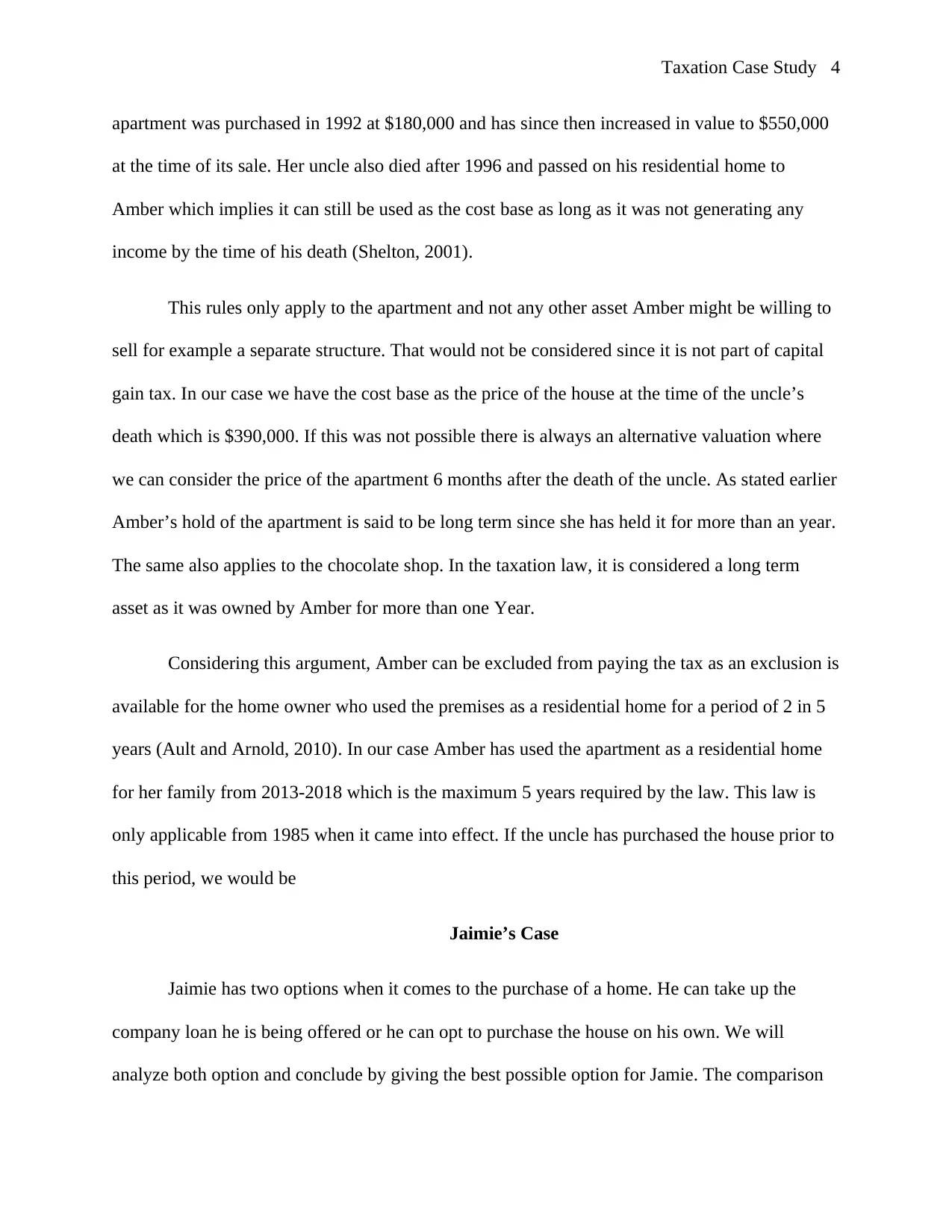
Taxation Case Study 4
apartment was purchased in 1992 at $180,000 and has since then increased in value to $550,000
at the time of its sale. Her uncle also died after 1996 and passed on his residential home to
Amber which implies it can still be used as the cost base as long as it was not generating any
income by the time of his death (Shelton, 2001).
This rules only apply to the apartment and not any other asset Amber might be willing to
sell for example a separate structure. That would not be considered since it is not part of capital
gain tax. In our case we have the cost base as the price of the house at the time of the uncle’s
death which is $390,000. If this was not possible there is always an alternative valuation where
we can consider the price of the apartment 6 months after the death of the uncle. As stated earlier
Amber’s hold of the apartment is said to be long term since she has held it for more than an year.
The same also applies to the chocolate shop. In the taxation law, it is considered a long term
asset as it was owned by Amber for more than one Year.
Considering this argument, Amber can be excluded from paying the tax as an exclusion is
available for the home owner who used the premises as a residential home for a period of 2 in 5
years (Ault and Arnold, 2010). In our case Amber has used the apartment as a residential home
for her family from 2013-2018 which is the maximum 5 years required by the law. This law is
only applicable from 1985 when it came into effect. If the uncle has purchased the house prior to
this period, we would be
Jaimie’s Case
Jaimie has two options when it comes to the purchase of a home. He can take up the
company loan he is being offered or he can opt to purchase the house on his own. We will
analyze both option and conclude by giving the best possible option for Jamie. The comparison
apartment was purchased in 1992 at $180,000 and has since then increased in value to $550,000
at the time of its sale. Her uncle also died after 1996 and passed on his residential home to
Amber which implies it can still be used as the cost base as long as it was not generating any
income by the time of his death (Shelton, 2001).
This rules only apply to the apartment and not any other asset Amber might be willing to
sell for example a separate structure. That would not be considered since it is not part of capital
gain tax. In our case we have the cost base as the price of the house at the time of the uncle’s
death which is $390,000. If this was not possible there is always an alternative valuation where
we can consider the price of the apartment 6 months after the death of the uncle. As stated earlier
Amber’s hold of the apartment is said to be long term since she has held it for more than an year.
The same also applies to the chocolate shop. In the taxation law, it is considered a long term
asset as it was owned by Amber for more than one Year.
Considering this argument, Amber can be excluded from paying the tax as an exclusion is
available for the home owner who used the premises as a residential home for a period of 2 in 5
years (Ault and Arnold, 2010). In our case Amber has used the apartment as a residential home
for her family from 2013-2018 which is the maximum 5 years required by the law. This law is
only applicable from 1985 when it came into effect. If the uncle has purchased the house prior to
this period, we would be
Jaimie’s Case
Jaimie has two options when it comes to the purchase of a home. He can take up the
company loan he is being offered or he can opt to purchase the house on his own. We will
analyze both option and conclude by giving the best possible option for Jamie. The comparison
Paraphrase This Document
Need a fresh take? Get an instant paraphrase of this document with our AI Paraphraser
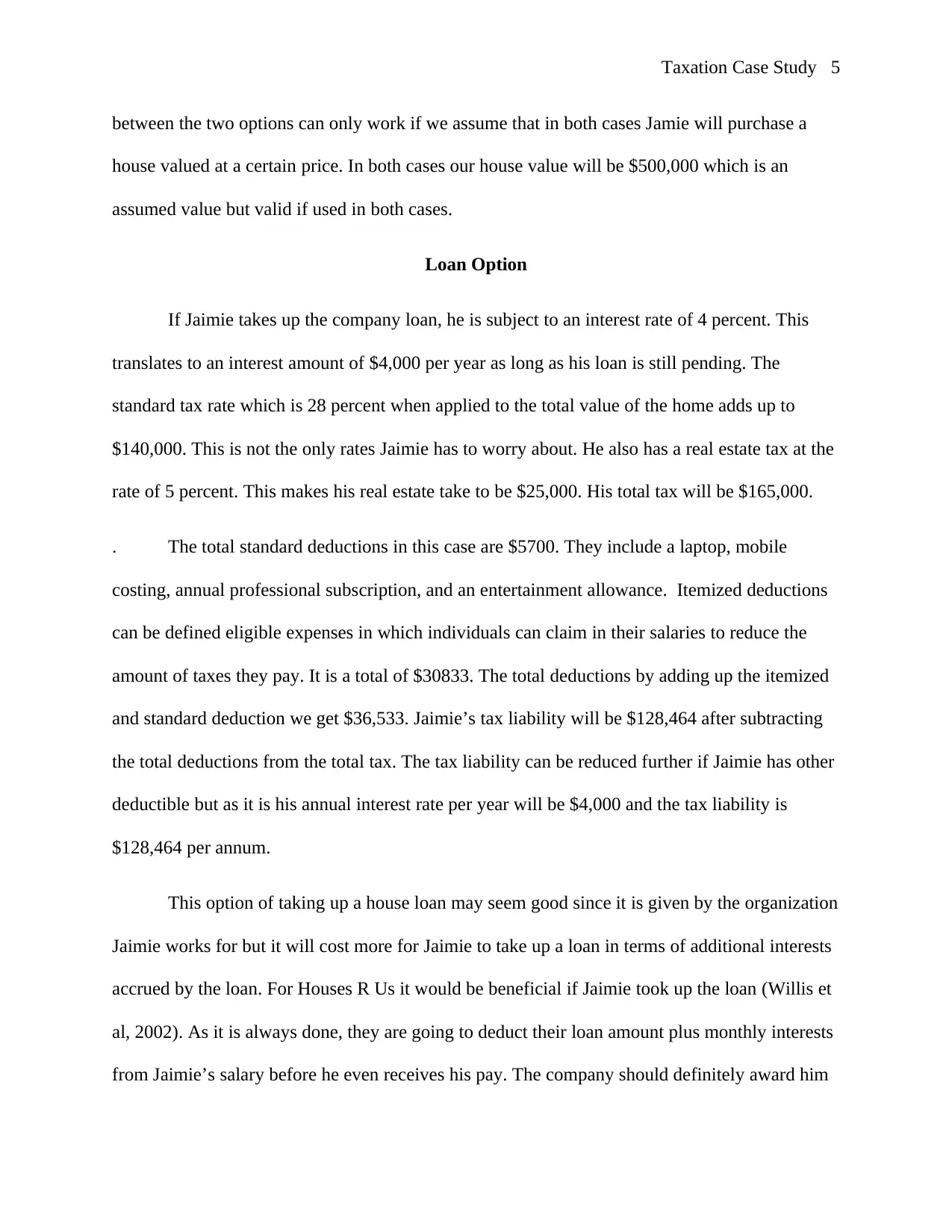
Taxation Case Study 5
between the two options can only work if we assume that in both cases Jamie will purchase a
house valued at a certain price. In both cases our house value will be $500,000 which is an
assumed value but valid if used in both cases.
Loan Option
If Jaimie takes up the company loan, he is subject to an interest rate of 4 percent. This
translates to an interest amount of $4,000 per year as long as his loan is still pending. The
standard tax rate which is 28 percent when applied to the total value of the home adds up to
$140,000. This is not the only rates Jaimie has to worry about. He also has a real estate tax at the
rate of 5 percent. This makes his real estate take to be $25,000. His total tax will be $165,000.
. The total standard deductions in this case are $5700. They include a laptop, mobile
costing, annual professional subscription, and an entertainment allowance. Itemized deductions
can be defined eligible expenses in which individuals can claim in their salaries to reduce the
amount of taxes they pay. It is a total of $30833. The total deductions by adding up the itemized
and standard deduction we get $36,533. Jaimie’s tax liability will be $128,464 after subtracting
the total deductions from the total tax. The tax liability can be reduced further if Jaimie has other
deductible but as it is his annual interest rate per year will be $4,000 and the tax liability is
$128,464 per annum.
This option of taking up a house loan may seem good since it is given by the organization
Jaimie works for but it will cost more for Jaimie to take up a loan in terms of additional interests
accrued by the loan. For Houses R Us it would be beneficial if Jaimie took up the loan (Willis et
al, 2002). As it is always done, they are going to deduct their loan amount plus monthly interests
from Jaimie’s salary before he even receives his pay. The company should definitely award him
between the two options can only work if we assume that in both cases Jamie will purchase a
house valued at a certain price. In both cases our house value will be $500,000 which is an
assumed value but valid if used in both cases.
Loan Option
If Jaimie takes up the company loan, he is subject to an interest rate of 4 percent. This
translates to an interest amount of $4,000 per year as long as his loan is still pending. The
standard tax rate which is 28 percent when applied to the total value of the home adds up to
$140,000. This is not the only rates Jaimie has to worry about. He also has a real estate tax at the
rate of 5 percent. This makes his real estate take to be $25,000. His total tax will be $165,000.
. The total standard deductions in this case are $5700. They include a laptop, mobile
costing, annual professional subscription, and an entertainment allowance. Itemized deductions
can be defined eligible expenses in which individuals can claim in their salaries to reduce the
amount of taxes they pay. It is a total of $30833. The total deductions by adding up the itemized
and standard deduction we get $36,533. Jaimie’s tax liability will be $128,464 after subtracting
the total deductions from the total tax. The tax liability can be reduced further if Jaimie has other
deductible but as it is his annual interest rate per year will be $4,000 and the tax liability is
$128,464 per annum.
This option of taking up a house loan may seem good since it is given by the organization
Jaimie works for but it will cost more for Jaimie to take up a loan in terms of additional interests
accrued by the loan. For Houses R Us it would be beneficial if Jaimie took up the loan (Willis et
al, 2002). As it is always done, they are going to deduct their loan amount plus monthly interests
from Jaimie’s salary before he even receives his pay. The company should definitely award him
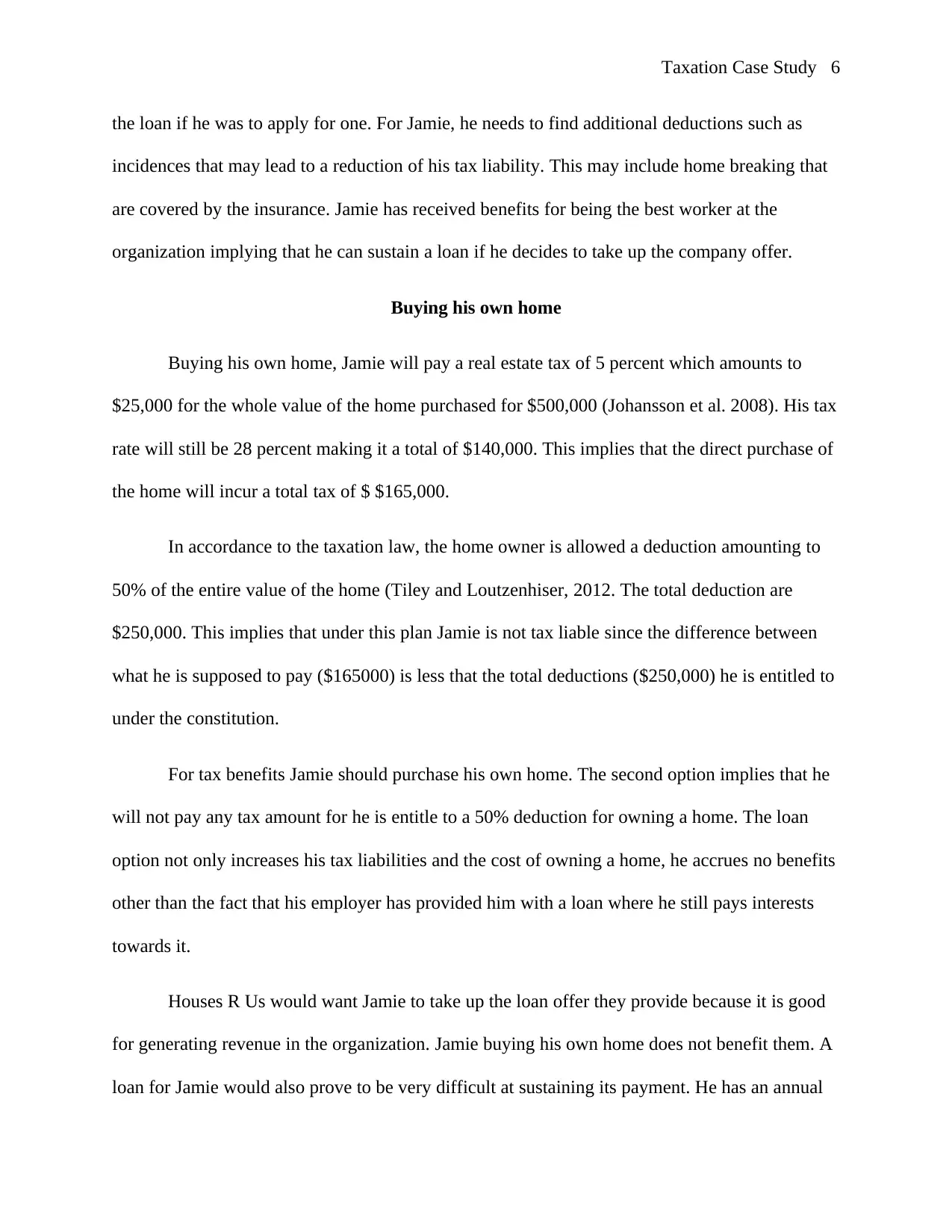
Taxation Case Study 6
the loan if he was to apply for one. For Jamie, he needs to find additional deductions such as
incidences that may lead to a reduction of his tax liability. This may include home breaking that
are covered by the insurance. Jamie has received benefits for being the best worker at the
organization implying that he can sustain a loan if he decides to take up the company offer.
Buying his own home
Buying his own home, Jamie will pay a real estate tax of 5 percent which amounts to
$25,000 for the whole value of the home purchased for $500,000 (Johansson et al. 2008). His tax
rate will still be 28 percent making it a total of $140,000. This implies that the direct purchase of
the home will incur a total tax of $ $165,000.
In accordance to the taxation law, the home owner is allowed a deduction amounting to
50% of the entire value of the home (Tiley and Loutzenhiser, 2012. The total deduction are
$250,000. This implies that under this plan Jamie is not tax liable since the difference between
what he is supposed to pay ($165000) is less that the total deductions ($250,000) he is entitled to
under the constitution.
For tax benefits Jamie should purchase his own home. The second option implies that he
will not pay any tax amount for he is entitle to a 50% deduction for owning a home. The loan
option not only increases his tax liabilities and the cost of owning a home, he accrues no benefits
other than the fact that his employer has provided him with a loan where he still pays interests
towards it.
Houses R Us would want Jamie to take up the loan offer they provide because it is good
for generating revenue in the organization. Jamie buying his own home does not benefit them. A
loan for Jamie would also prove to be very difficult at sustaining its payment. He has an annual
the loan if he was to apply for one. For Jamie, he needs to find additional deductions such as
incidences that may lead to a reduction of his tax liability. This may include home breaking that
are covered by the insurance. Jamie has received benefits for being the best worker at the
organization implying that he can sustain a loan if he decides to take up the company offer.
Buying his own home
Buying his own home, Jamie will pay a real estate tax of 5 percent which amounts to
$25,000 for the whole value of the home purchased for $500,000 (Johansson et al. 2008). His tax
rate will still be 28 percent making it a total of $140,000. This implies that the direct purchase of
the home will incur a total tax of $ $165,000.
In accordance to the taxation law, the home owner is allowed a deduction amounting to
50% of the entire value of the home (Tiley and Loutzenhiser, 2012. The total deduction are
$250,000. This implies that under this plan Jamie is not tax liable since the difference between
what he is supposed to pay ($165000) is less that the total deductions ($250,000) he is entitled to
under the constitution.
For tax benefits Jamie should purchase his own home. The second option implies that he
will not pay any tax amount for he is entitle to a 50% deduction for owning a home. The loan
option not only increases his tax liabilities and the cost of owning a home, he accrues no benefits
other than the fact that his employer has provided him with a loan where he still pays interests
towards it.
Houses R Us would want Jamie to take up the loan offer they provide because it is good
for generating revenue in the organization. Jamie buying his own home does not benefit them. A
loan for Jamie would also prove to be very difficult at sustaining its payment. He has an annual
⊘ This is a preview!⊘
Do you want full access?
Subscribe today to unlock all pages.

Trusted by 1+ million students worldwide
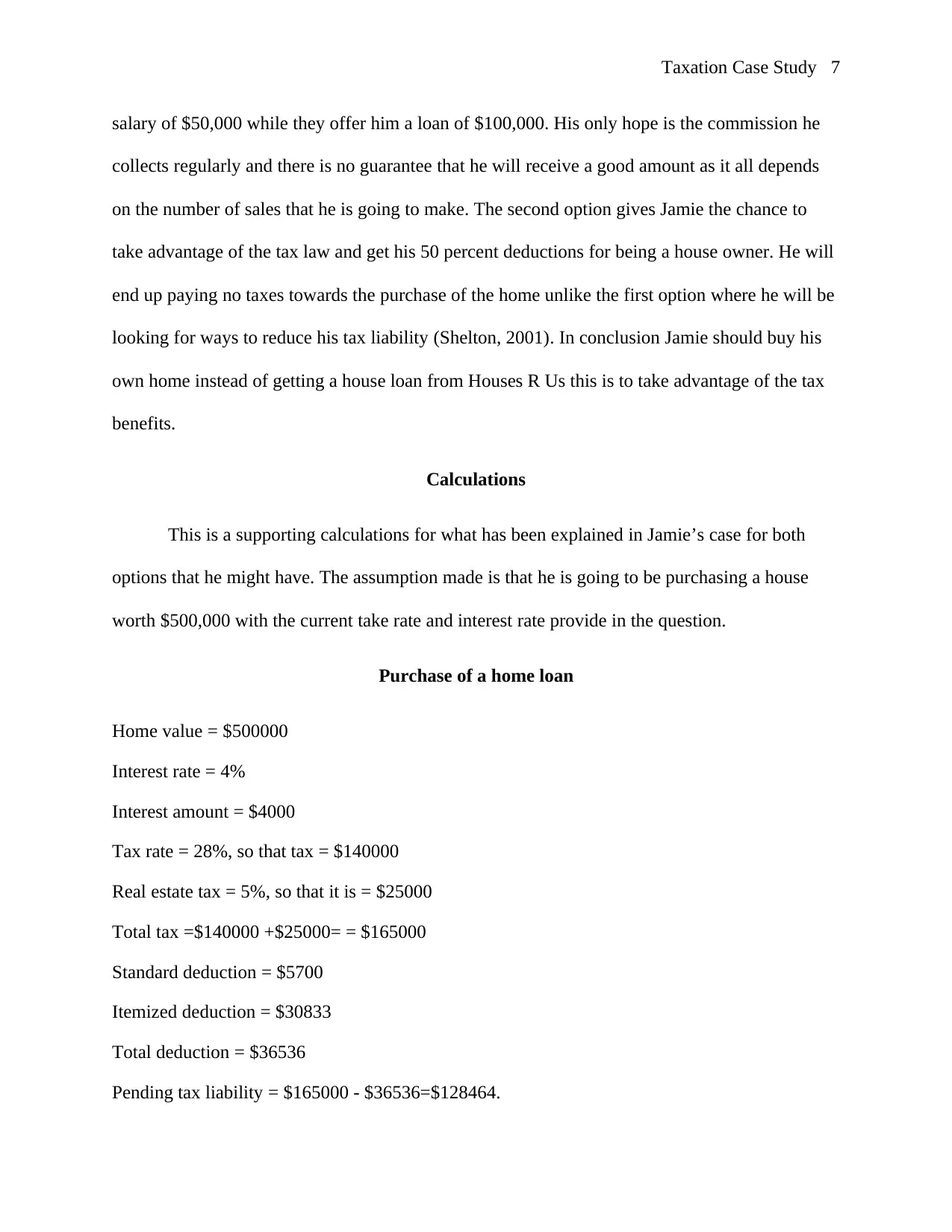
Taxation Case Study 7
salary of $50,000 while they offer him a loan of $100,000. His only hope is the commission he
collects regularly and there is no guarantee that he will receive a good amount as it all depends
on the number of sales that he is going to make. The second option gives Jamie the chance to
take advantage of the tax law and get his 50 percent deductions for being a house owner. He will
end up paying no taxes towards the purchase of the home unlike the first option where he will be
looking for ways to reduce his tax liability (Shelton, 2001). In conclusion Jamie should buy his
own home instead of getting a house loan from Houses R Us this is to take advantage of the tax
benefits.
Calculations
This is a supporting calculations for what has been explained in Jamie’s case for both
options that he might have. The assumption made is that he is going to be purchasing a house
worth $500,000 with the current take rate and interest rate provide in the question.
Purchase of a home loan
Home value = $500000
Interest rate = 4%
Interest amount = $4000
Tax rate = 28%, so that tax = $140000
Real estate tax = 5%, so that it is = $25000
Total tax =$140000 +$25000= = $165000
Standard deduction = $5700
Itemized deduction = $30833
Total deduction = $36536
Pending tax liability = $165000 - $36536=$128464.
salary of $50,000 while they offer him a loan of $100,000. His only hope is the commission he
collects regularly and there is no guarantee that he will receive a good amount as it all depends
on the number of sales that he is going to make. The second option gives Jamie the chance to
take advantage of the tax law and get his 50 percent deductions for being a house owner. He will
end up paying no taxes towards the purchase of the home unlike the first option where he will be
looking for ways to reduce his tax liability (Shelton, 2001). In conclusion Jamie should buy his
own home instead of getting a house loan from Houses R Us this is to take advantage of the tax
benefits.
Calculations
This is a supporting calculations for what has been explained in Jamie’s case for both
options that he might have. The assumption made is that he is going to be purchasing a house
worth $500,000 with the current take rate and interest rate provide in the question.
Purchase of a home loan
Home value = $500000
Interest rate = 4%
Interest amount = $4000
Tax rate = 28%, so that tax = $140000
Real estate tax = 5%, so that it is = $25000
Total tax =$140000 +$25000= = $165000
Standard deduction = $5700
Itemized deduction = $30833
Total deduction = $36536
Pending tax liability = $165000 - $36536=$128464.
Paraphrase This Document
Need a fresh take? Get an instant paraphrase of this document with our AI Paraphraser
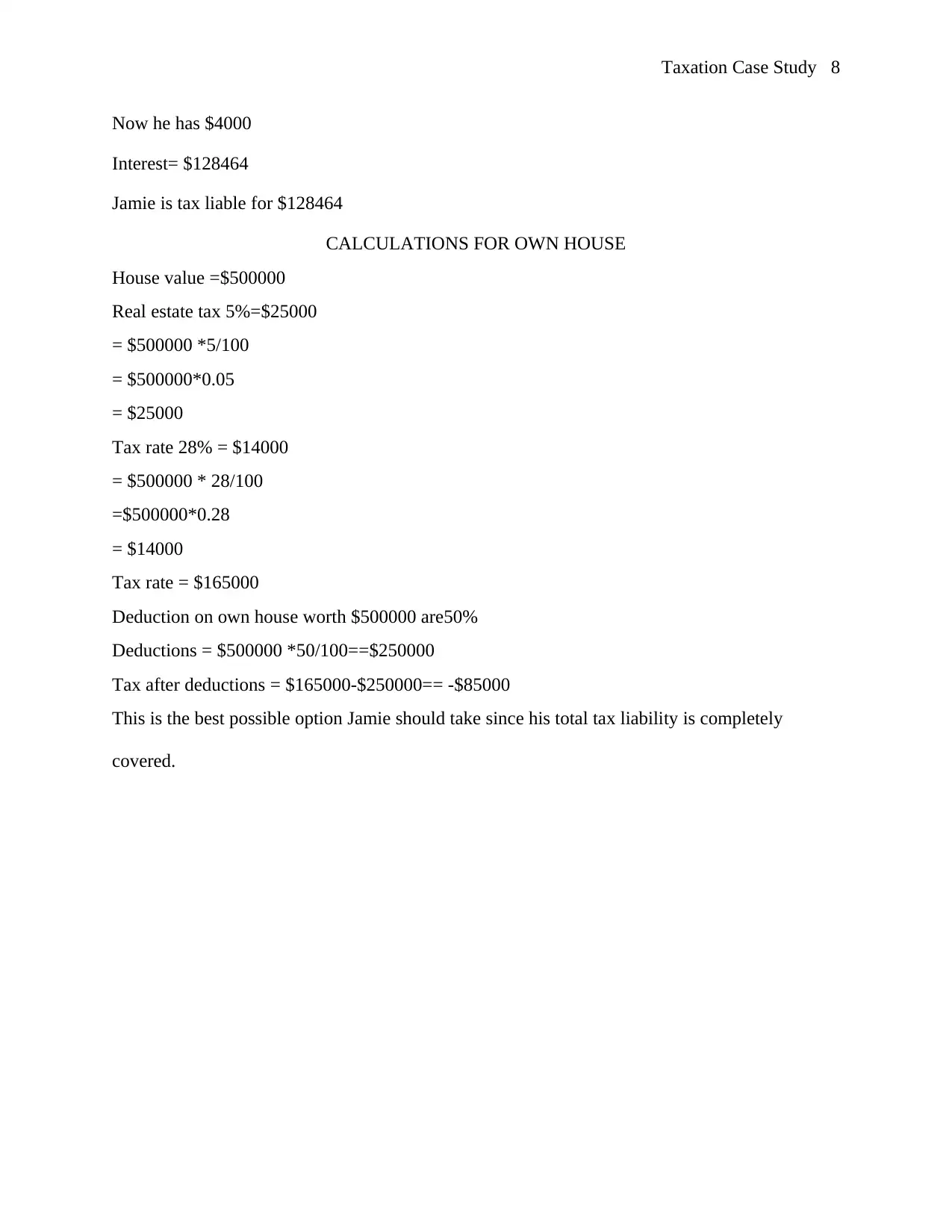
Taxation Case Study 8
Now he has $4000
Interest= $128464
Jamie is tax liable for $128464
CALCULATIONS FOR OWN HOUSE
House value =$500000
Real estate tax 5%=$25000
= $500000 *5/100
= $500000*0.05
= $25000
Tax rate 28% = $14000
= $500000 * 28/100
=$500000*0.28
= $14000
Tax rate = $165000
Deduction on own house worth $500000 are50%
Deductions = $500000 *50/100==$250000
Tax after deductions = $165000-$250000== -$85000
This is the best possible option Jamie should take since his total tax liability is completely
covered.
Now he has $4000
Interest= $128464
Jamie is tax liable for $128464
CALCULATIONS FOR OWN HOUSE
House value =$500000
Real estate tax 5%=$25000
= $500000 *5/100
= $500000*0.05
= $25000
Tax rate 28% = $14000
= $500000 * 28/100
=$500000*0.28
= $14000
Tax rate = $165000
Deduction on own house worth $500000 are50%
Deductions = $500000 *50/100==$250000
Tax after deductions = $165000-$250000== -$85000
This is the best possible option Jamie should take since his total tax liability is completely
covered.
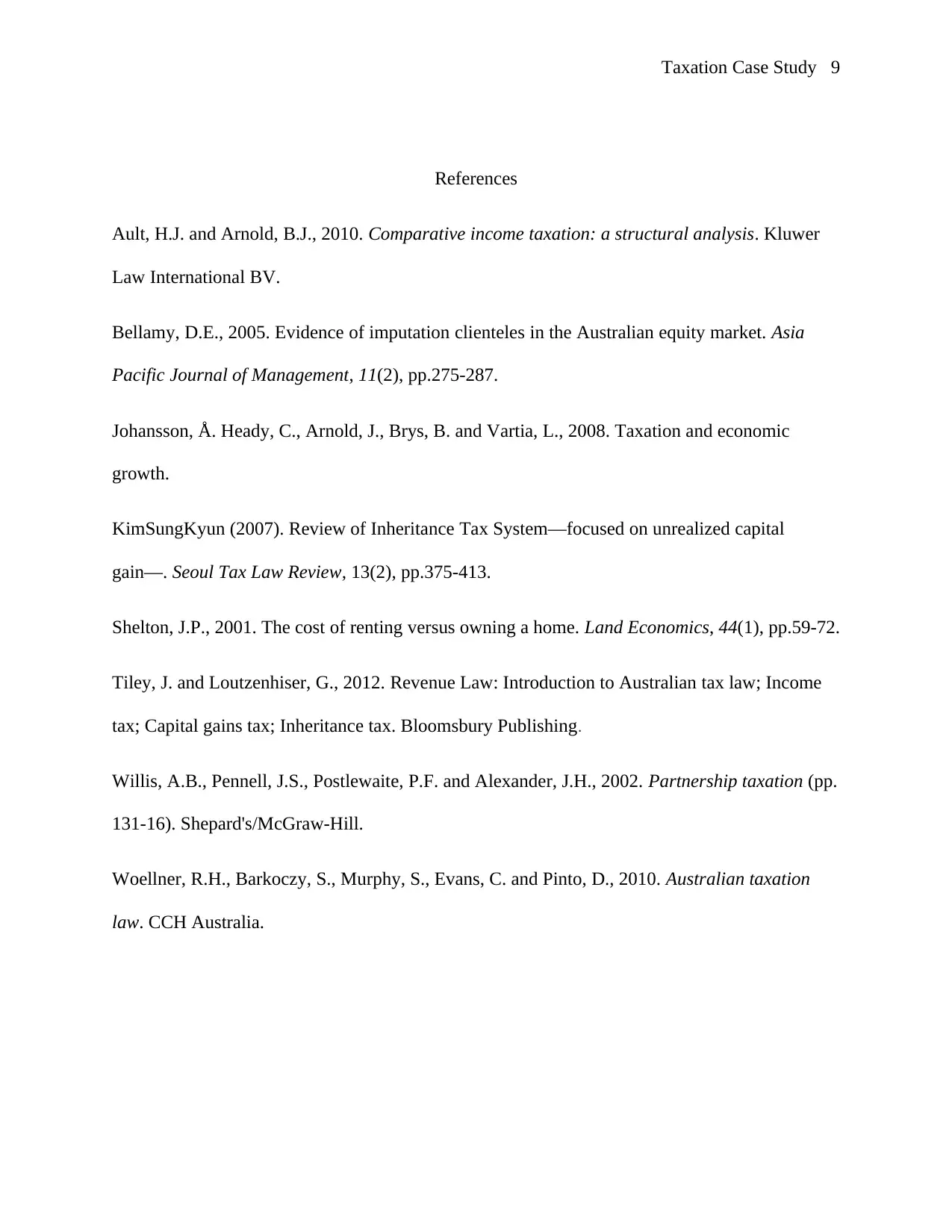
Taxation Case Study 9
References
Ault, H.J. and Arnold, B.J., 2010. Comparative income taxation: a structural analysis. Kluwer
Law International BV.
Bellamy, D.E., 2005. Evidence of imputation clienteles in the Australian equity market. Asia
Pacific Journal of Management, 11(2), pp.275-287.
Johansson, Å. Heady, C., Arnold, J., Brys, B. and Vartia, L., 2008. Taxation and economic
growth.
KimSungKyun (2007). Review of Inheritance Tax System―focused on unrealized capital
gain―. Seoul Tax Law Review, 13(2), pp.375-413.
Shelton, J.P., 2001. The cost of renting versus owning a home. Land Economics, 44(1), pp.59-72.
Tiley, J. and Loutzenhiser, G., 2012. Revenue Law: Introduction to Australian tax law; Income
tax; Capital gains tax; Inheritance tax. Bloomsbury Publishing.
Willis, A.B., Pennell, J.S., Postlewaite, P.F. and Alexander, J.H., 2002. Partnership taxation (pp.
131-16). Shepard's/McGraw-Hill.
Woellner, R.H., Barkoczy, S., Murphy, S., Evans, C. and Pinto, D., 2010. Australian taxation
law. CCH Australia.
References
Ault, H.J. and Arnold, B.J., 2010. Comparative income taxation: a structural analysis. Kluwer
Law International BV.
Bellamy, D.E., 2005. Evidence of imputation clienteles in the Australian equity market. Asia
Pacific Journal of Management, 11(2), pp.275-287.
Johansson, Å. Heady, C., Arnold, J., Brys, B. and Vartia, L., 2008. Taxation and economic
growth.
KimSungKyun (2007). Review of Inheritance Tax System―focused on unrealized capital
gain―. Seoul Tax Law Review, 13(2), pp.375-413.
Shelton, J.P., 2001. The cost of renting versus owning a home. Land Economics, 44(1), pp.59-72.
Tiley, J. and Loutzenhiser, G., 2012. Revenue Law: Introduction to Australian tax law; Income
tax; Capital gains tax; Inheritance tax. Bloomsbury Publishing.
Willis, A.B., Pennell, J.S., Postlewaite, P.F. and Alexander, J.H., 2002. Partnership taxation (pp.
131-16). Shepard's/McGraw-Hill.
Woellner, R.H., Barkoczy, S., Murphy, S., Evans, C. and Pinto, D., 2010. Australian taxation
law. CCH Australia.
⊘ This is a preview!⊘
Do you want full access?
Subscribe today to unlock all pages.

Trusted by 1+ million students worldwide
1 out of 9
Related Documents
Your All-in-One AI-Powered Toolkit for Academic Success.
+13062052269
info@desklib.com
Available 24*7 on WhatsApp / Email
![[object Object]](/_next/static/media/star-bottom.7253800d.svg)
Unlock your academic potential
Copyright © 2020–2025 A2Z Services. All Rights Reserved. Developed and managed by ZUCOL.





